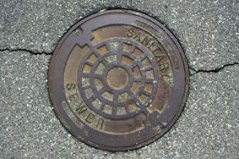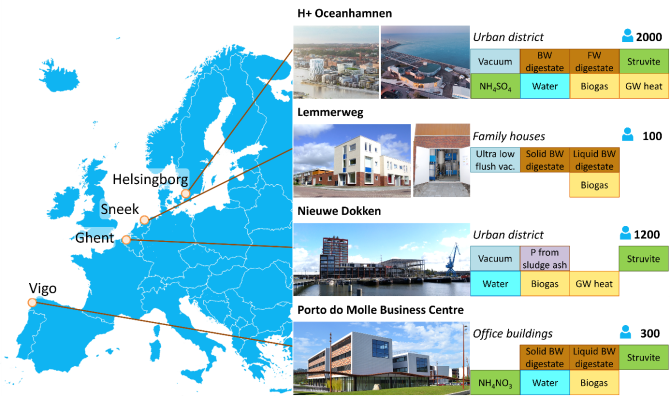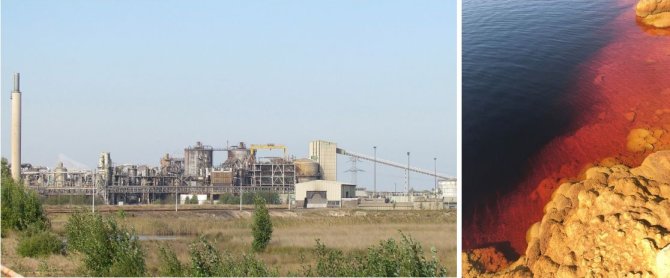Renewable resources for a circular economy (ETM)
Waste and wastewater systems were designed and implemented to protect humans and the environment from pollutants. Nowadays, circularity is an additional criterion for materials-conveyance systems. Used materials must remain available for reuse, with minimal value destruction. Striving for circularity is largely driven by rising awareness that endless natural resource use jeopardises planetary health and human well-being, regardless of specific scarcity threats. Phosphorous is an element for which scarcity and related geopolitical issues are widely known, but exhaustion of other elements (copper, zinc) is also a threat. Furthermore, circular material cycling can prevent environmental impacts associated with current linear material use.
We evaluate options to restore resource cycling (water, carbon, nutrients, minerals), especially through recovery from waste streams, by combining microbiological and physical-chemical processes.
An important waste stream in society is domestic wastewater. Current collection and treatment systems were designed to protect humans and the environment from sewage’s harmful effects. Systems were neither aimed at nor suited for recovering valuable resources. Organic matter in wastewaters is often removed vis-a-vis aerobic microorganisms, but the needed forced aeration at treatment plants consumes large amounts of energy, whereas organic matter is a potential source of energy. Additionally, nitrogen and phosphorous are traditionally regarded as pollutants, not resources -- a vice, not a virtue. Substantial effort and energy is spent on removing compounds from sewage, whereby nitrogen is released to the atmosphere as N2. Meanwhile, society produces artificial N-fertiliser through the energy-intensive Haber-Bosch process. Municipal wastewaters also contain other nutrient elements present in human excreta (potassium, magnesium, selenium, boron, etc). Crucially, sewage contains that most essential resource: water.


For about 20 years, we have developed new concepts, with circularity as prime criterion besides environmental and hygienic safety. This work has led to various new concepts, with the common objective to minimise resource dilution by separating human excreta (black water) carrying the bulk of organic matter and nutrients from diluted grey water originating from household activities (showering, laundry, etc). In these systems, known in the Netherlands as Novel Sanitation, industrial wastewaters are also separately managed, which also ensures that excreta’s food-originating nutrients are not mixed with industrial pollutants. This facilitates making relatively clean nutrient products from nutrient-rich concentrated excreta. Resource recovery from concentrated flows also more efficiently removes unwanted compounds (e.g. pharmaceuticals). In our new breakthrough concept, highly concentrated blackwater is digested at high temperature, producing biogas and inactivating pathogens, furthering reuse of resulting streams as organic fertiliser. High-temperature anaerobic digestion is developed and demonstrated in Horizon 2020 project Run4Life, in which we are a partner.
European Novel Sanitation systems are currently implemented in new residential areas of up to 2000 inhabitants. At these sites, state-of-the-art and innovative technological solutions optimise resource recovery while ensuring human and environmental safety. Countries with executed, planned projects include Canada, Sweden, Germany, Belgium and the Netherlands. Figure 1 shows Run4Life’s four demonstration sites. Here, Novel Sanitation shows full-scale concept maturity.

Realising a circular economy entails alternative sources for carbon-based chemicals originating from fossil sources or environment-degrading agricultures, such as palm oil industries. Microbial chain elongation is an alternative developed to produce ‘oily’ carbon-based chemicals, help recycle organic waste streams and sequester CO2 to form products (isobutyric acid, n-caproic acid, n-hexanol). More recalcitrant wastes can be valorised by introducing gasification – a high-temperature process that transforms carbon material into syngas, a CO, H2 and CO2 mixture. Syngas can be fermented to several products (e.g., n-caproic acid; n-hexanol). Further technological development facilitates sustainable circular economy transition. Microbial chain elongation fermentation from organic waste streams is undergoing its first full-scale implementation in Amsterdam by ChainCraft B.V., an ETM spin-off.
More stringent legislation on wastewater discharge and waste storing facilities, increasing scarcity of resources and higher metal prices warrants improved metal removal and recovery technologies. Microorganisms reducing sulphate and elemental sulphur to produce sulphide form the basis of the ETM cluster’s sulphur-reducing technology, successfully applied at Nyrstar’s zinc smelter plant (Budel-Dorplein, the Netherlands) to avoid pollution and minimise metal loss. Sulphide precipitates heavy metals, which can then be easily separated from the liquid and recovered. To extend this technology’s potential, we study biological reduction of sulphur by extremophilic microorganisms, growing at low pH and high temperature. This microbial process could be applied in the Dominican Republic to recover copper.

Biorecovery possibilities in resource recovery, materials upgrade, chemical production, water sources protection, energy reduction and chemical use are as diverse as the microorganisms employed. As results demonstrate, our concepts have developed into full-scale solutions; others will soon be realised.